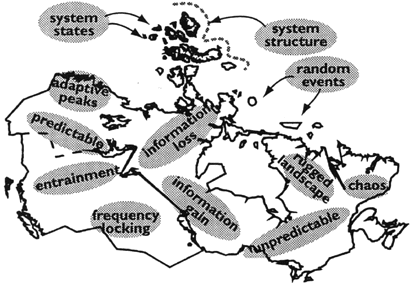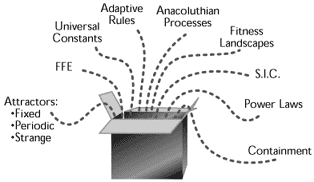
“Complexity
Science and Health Care Organizations:
Leadership in Complex Systems”
In
which Jeffrey Goldstein offered a business context for complexity theory.
Jeffrey Goldstein, PhD, Professor, School of Business,
Adelphi University
Coming to terms
with your confusion
- In dealing with
leadership and complexity, are we confronting a blurred picture of a
clear situation or, a clear picture of a blurred situation?
- It’s even more
difficult than that. We’re facing a blurred picture of a blurred situation.
- Goldstein observed:
“This conference is building a bridge, but we’re all doing it together.
I’m not going to clear up the questions you have from the last presentation.
In fact, I may make things more confusing.”
- Goldstein affirmed
that feelings of confusion are natural – even appropriate. Change is
so rapid, we can’t deny it anymore. Confusion is an appropriate response.
We must make unintuitive choices: The fire metaphor
- Consider the true
story about the 1949 Mann Gulch fire. A group of “smoke jumper” forrest
fire fighters were trapped on the top of a hill with the fire raging
up towards them. The leader realized the fire was moving faster than
any of them could run. Trapped in a field of high, dry grass, he made
a counter-intuitive, seemingly crazy move: he set fire to the grass
around them.
Because he’d burnt out the grass around them, the fire burnt around that area. Who would have thought to start a fire in the middle of one? It seemed truly crazy. But it saved three lives.
- Such escape fires
are now in the manuals. But it wasn’t part of the mental model of those
smoke jumpers.
- Health care today is not unlike this fire. Change is burning the market faster than we can run. We must rethink our assumptions about how to lead health care organizations.
Some hard questions you’ve probably been asking yourself:
- What the hell
are we doing here listening to esoteric mathematical constructs?
- Why should we
learn this when there’s a fire coming up the hill?
- Why are we listening
to talk about complexity science?What about
complexity science makes it so important? Why not gauge theory? Or the human genome? Or superstring theory? Why complexity?
- In Israel several
years ago, Goldstein saw copies a book on Chaos, translated into Hebrew
on newsstands. In Israel, complexity science, with its emphasis on emerging
pattern and order, had entered the national dialogue.
- Similarly, Goldstein
did a search in 1993 on use of the world “self-organization” in Sociology.
The search turned up about 35 references. About 25 of those were in
Serbo-Croatian literature in the 1980s. Intrigued, Goldstein investigated
and discovered a situation similar to that in Israel: the breakdown
of an old system was taking place, and Croatians were looking for new
ways to think about what was going on.
Likewise, these concepts are emerging in health care
- Like the upheaval
that led to a search for new approaches in Israel and Serbo-Croatia,
the health care industry needs innovation in the face of upheaval.
- We need the kind of counter-intuitive innovation displayed by the fire-fighting techniques in the Mann Gulch fire.
Self-organization isn’t always a good thing.
- Is self-organization
always a good thing? Not necessarily. The events leading to war in Yugoslavia
were self-organizing. The ethnic hatred self-organized.
- It’s not enough
just to stand back and let things self-organize. This leads to an important
question: To what extent can we guide processes of self-organization
to make them more constructive?
- When do we keep
the traditional elements of organizations and when do we let them go?
We can explore these questions in the spirit of play.

- We’re now living
in Complexityland. Imagine a landscape, in which some regions are linear
and predictable; others are self-organizing critical states;
regions that are unpredictable; and others that we can
make more predictable.
- Thus, there is
no one approach, and no one model that works in all situations.
| Real emergence depends on organizational structure. |
|
Source
of
Structure |
Self- organized
|
Informal
leadership
|
Emergent
networks
|
|
Imposed
|
Command
& Control bureaucracy
|
Imposed
teams (quality, etc.)
|
|
|
Hierarchical
|
Participative
|
||
|
Type
of Structure
|
|||
- Command
and control (lower left quadrant.) Many managers
don’t want to admit that most structures are still of this variety.
Emergence cannot take place here.
- Imposed teams
(lower right quadrant.) These may seem to be self organizing, but they
are not. You can’t say, “I demand that you be participative.”
- Informal leadership
(upper left quadrant.) This is a spontaneous, self-organizing structure...
but as soon as there is a crisis, the leader steps in and “commands
the troops.” Real emergence can’t take place.
- Emergent networks (upper right quadrant.) Emergent networks hold potential for real innovation... but they occur only when conditions are right. These networks are a threat to many leaders, and the traditional way they think organizations should be run. Indeed, emergent networks are “out of control.”
Opening the “black box” of emergence

- We now know a
lot more about emergent phenomena. We can look inside “the black box”
and understand some of its processes.
- Anacoluthian Processes are a key element in the black box. Anacoluthian refers to a “logical inconsistency.” Order can be found in noise, and noise can be found in order. This pattern creates marvelous possibilities.
Summary: Key points
- Innovation must be based
on allowing random events and violating old rules. Managers traditionally
try to eliminate uncontrolled random events. Yet, that’s where
innovation comes from, just as the fire fighters realized the need to
set fire to the field in which they were standing during a forrest fire.
- Organizations have to
turn themselves inside out to be open to random events.
- A difficult, rhetorical question: How, Goldstein asked, can we be the kind of “wizard” who can enable people to be open to anacoluthian processes, yet guide emergence in a positive way?
Copyright
© 1999, VHA Inc. Permission
to copy for educational purposes only.